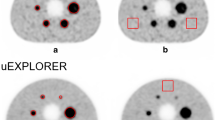Abstract
Purpose
The purpose was to investigate the effects of short acquisition time on the image quality and the lesion detectability of oncological 18F-FDG total-body PET/CT.
Methods
Nineteen oncological patients (6/13 women/men, age 65.6 ± 9.4 years) underwent total-body PET/CT on uEXPLORER scanner using 3D list mode. The administration of 18F-FDG was weight-based (4.4 MBq/kg). The acquisition time was 900 s, and PET data were reconstructed into 900-, 180-, 120-, 60-, 30-, and 18-s duration groups. The subjective PET image quality was scored using a 5-point scale (5, excellent; 1, poor) in 3 perspectives: overall quality, noise, and lesion conspicuity. The objective image quality was evaluated by SUVmax and standard deviation (SD) of the liver, SUVmax of the tumor, and tumor-to-background ratio (TBR). The lesion detectability was the percentage of identifiable lesions in the groups of 180 to 18 s using the group 900 s as reference.
Results
Our results showed that sufficient and acceptable subjective image quality could be achieved with 60- and 30-s groups, and good image quality scores were given to 180- and 120-s groups without significant difference. For shortened acquisition time, SD was increased, while SUVmax of tumor and TBR remained unchanged. The lesion detectability was decreased with shorter acquisition time, but the detection performance could be maintained until the 60-s group compared with the 900-s group, although the image quality degraded.
Conclusion
The total-body PET/CT can significantly shorten the acquisition time with maintained lesion detectability and image quality.





Similar content being viewed by others
References
Boellaard R, Delgado-Bolton R, Oyen WJ, et al. FDG PET/CT: EANM procedure guidelines for tumour imaging: version 2.0. Eur J Nucl Med Mol Imaging. 2015;42(2):328–54.
Zhang X, Cherry SR, Xie Z, Shi H, Badawi RD, Qi J. Subsecond total-body imaging using ultrasensitive positron emission tomography. Proc Natl Acad Sci U S A. 2020;117(5):2265–7.
Badawi RD, Shi H, Hu P, et al. First human imaging studies with the EXPLORER total-body PET scanner. J Nucl Med. 2019;60(3):299–303.
Zhang X, Xie Z, Berg E, et al. Total-body dynamic reconstruction and parametric imaging on the uEXPLORER. J Nucl Med. 2020;61(2):285–91.
Cherry SR, Jones T, Karp JS, Qi J, Moses WW, Badawi RD, et al. Maximizing sensitivity to create new opportunities for clinical research and patient care. J Nucl Med. 2018;59(1):3–12.
Zhang X, Zhou J, Cherry SR, Badawi RD, Qi J. Quantitative image reconstruction for total-body PET imaging using the 2-meter long EXPLORER scanner. Phys Med Biol. 2017;62(6):2465–85.
Pan T, Einstein SA, Kappadath SC, et al. Performance evaluation of the 5-ring GE discovery MI PET/CT system using the national electrical manufacturers association NU 2-2012 standard. Med Phys. 2019;46(7):3025–33.
Pantel AR, Viswanath V, Daube-Witherspoon ME, et al. PennPET Explorer: human imaging on a whole-body imager. J Nucl Med. 2020;61(1):144–51.
van der Vos CS, Koopman D, Rijnsdorp S, et al. Quantification, improvement, and harmonization of small lesion detection with state-of-the-art PET. Eur J Nucl Med Mol Imaging. 2017;44(Suppl 1):4–16.
van Sluis J, Boellaard R, Dierckx RA, Stormezand G, Glaudemans AWJM, Noordzij W. Image quality and activity optimization in oncological18F-FDG PET using the digital Biograph Vision PET/CT. J Nucl Med 2019. https://doi.org/10.2967/jnumed.119.234351.
Deng Z, Hu D, Ding Y, Dong Y. A comparison of image quality with uMI780 and the first total-body uEXPLORER scanner. J Nucl Med. 2019;60(Supplement 1):381.
Matheoud R, Leva L, Secco C, et al. Small lesions detectability with the Biograph 16 Hi-Rez PET/CT scanner and fast imaging protocols: performance evaluation using an anthropomorphic thoracic phantom and ROC analyses. Ann Nucl Med. 2011;25(3):179–88.
Lindemann ME, Stebner V, Tschischka A, Kirchner J, Umutlu L, Quick HH. Towards fast whole-body PET/MR: investigation of PET image quality versus reduced PET acquisition times. PLoS One. 2018;13(10):e0206573.
Noto B, Büther F, Auf der Springe K, et al. Impact of PET acquisition durations on image quality and lesion detectability in whole-body 68Ga-PSMA PET-MRI. EJNMMI Res. 2017;7(1):12.
Goethals I, D'Asseler Y, Dobbeleir A, Deblaere K, Ham H. The effect of acquisition time on visual and semi-quantitative analysis of F-18 FDG-PET studies in patients with head and neck cancer. Nucl Med Commun. 2010;31(3):227–31.
Funding
This research was supported in part by the National Key Research and Development Program of China (2016YFC10103908), the National Natural Science Foundation of China (81471706, and 81671735), Shanghai Science and Technology Project (17511104201), Shanghai Municipal Key Clinical Specialty (shslczdzk03401), and Shanghai Municipal Health and Family Planning Commission Youth Fund of China (20164Y0113).
Author information
Authors and Affiliations
Corresponding author
Ethics declarations
Conflict of interest
Run-Ze Wu is an employee of United Imaging Research. The other authors working with Zhongshan Hospital have full control of the data and declare that they have no conflict of interest.
Ethical approval
All procedures performed in studies involving human participants were in accordance with the ethical standards of the institutional and/or national research committee and with the 1964 Helsinki declaration and its later amendments or comparable ethical standards.
Informed consent
Informed consent was obtained from all individual participants included in the study.
Additional information
Publisher’s note
Springer Nature remains neutral with regard to jurisdictional claims in published maps and institutional affiliations.
This article is part of the Topical Collection on Technology
Electronic supplementary material
ESM 1
(DOCX 19 kb).
Rights and permissions
About this article
Cite this article
Zhang, YQ., Hu, PC., Wu, RZ. et al. The image quality, lesion detectability, and acquisition time of 18F-FDG total-body PET/CT in oncological patients. Eur J Nucl Med Mol Imaging 47, 2507–2515 (2020). https://doi.org/10.1007/s00259-020-04823-w
Received:
Accepted:
Published:
Issue Date:
DOI: https://doi.org/10.1007/s00259-020-04823-w




